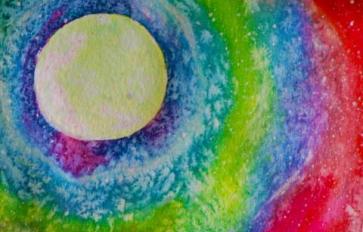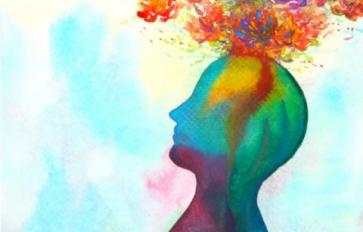
Also known as sun-eating, the practice of staring into the sun at sunrise and sunset is an age-old technique for stimulating the pineal gland, fostering health and reaching beyond current states of limited thinking and the way one experiences life.
My first experience of sun-gazing was by “accident” while living on the beaches of India in the early 2000's. It was part of life and the natural synchronization of nature that happens when living so closely with the elements, that you would not only notice, but attune with the sun and the moon and the gifts they offer. I had no previous knowledge or list of protocols, just me and the sun every night, watching the golden globe of light drop slowly behind the distant waters edge.
I must have stared for 15-30 minutes, maybe more, nightly. It never crossed my mind that you wouldn't want to – it was natural and compelling to watch the spectacle that nature provides every single evening to close down the day. The rising of the moon was just as glorious and often times I would lie on the beach and watch her travel the expanse throughout the night, missing sleep.
The magical and even unbelievable gifts and experiences I met with while during my stay with the planetary bodies remains unparalleled in my city life of today. Hardly, if ever, do I find space or time to peek through the maze of apartments and traffic to find the setting sun. Out my breakfast window in the morning between cries of hungry children and coffee brewing, I can sometimes catch the first rays of day, but I am hard-pressed. It was much easier when I walked the beaches and slept in bungalows at the edge of the surf.
It isn't always so cut and dry, that the sun is there for you daily without limit, or that impossibility reigns instead, standing in the way of the potential magic. Most people stand somewhere in the middle, where they could sun-gaze, even regularly, if they knew how and if they knew why.
Sun-gazing is an ancient practice used by yogis and tribal people alike to reap the power and potency of the sun at both sunrise and sunset (when U.V. Rays are low). By incrementally building up the amount of time spent looking into the sun at these low impact times (during the first hour after sunrise or the first hour prior to sunset), one is able to activate the pineal gland in ways that can rarely be found elsewhere.
The pineal gland responds to light. It is where we release melatonin and it is responsible for sleep patterns and what you might call “awaken” patterns, or awakening patterns. When flooded with sunlight, the pineal gland starts to come alive, to fill with liquid, as it is meant to, and to release hormones that can do many things, including reverse disease and reduce hunger and the body's need for food.
Think of it like cutting out the “middle man.” The sunlight is what gives plants and fruits/veggies their color, nutrients, and enzymes. The soil is nourished through contact with the sun's life-giving rays. By looking into the sun and “receiving” the gifts of its potency, through the eyes, the pineal gland activates, detoxifies and slowly begins to reveal its secrets - one of which is a deeper awareness of what is beyond.
There are several important aspects to sun-gazing that absolutely MUST be adhered to if you choose to incorporate sun-gazing into your life. One is that you must ONLY sun-gaze during appropriate times of day – as mentioned above. These times are during the hour after sunrise and the hour before sunset, due to the low UV during these times. The other rule is that shoes must be removed and the gazer should be standing barefoot on the earth. This helps the body to process the intense rays of the sun, and to ground out any extra solar energy. These are the two main restrictions/rules. Other than these, it is recommended to start at 10 seconds and add 10 seconds for each day you gaze that follows. If missing a day, it is recommended to reduce by 10 seconds for however many days you missed. So you can see, if you are gazing randomly, you want to slowly build your time to protect the eyes.
Other precautions are that if you gaze and eyes become watery and wish to blink, it is an indication that 1 – you are detoxing the eyes, and this is good, but also 2 – the rays may be particularly potent for you that time, and it is a good idea to honor the cues from the body and not try to “push through.” Just give your body due time to adjust, as it will in time.
There are many who report feeling less hungry when sun-gazing for extended periods of time. I too have experienced this to an extent. Everyone is different, so it depends on the individual what experience you will have. Sun-gazing can also start spontaneous healing-like symptoms in the body due to the increase in Vitamin D and the healing rays of the sun on the brain and pineal gland. It might not be uncommon to experience what feels to be “extra-ordinary” events or occurrences during your sun-gazing time. Also, this is unique to each person, but should be remembered if and when you begin this practice, that you may tap some of what the Indians refer to as “siddhis” through this practice.
In India, this practice is one form of trataka – or still point gazing. For the beginner, it is recommended to practice trataka first, in front of a candle flame, and then to gradually build up to the sun. Other points of focus can be used instead such as a dot drawn on the wall, a mandala, another person's eyes, the moon, a tree, or various other objects. The sun is the most potent object of meditation and for this reason, also the most powerful for purifying the mind and opening to deeper psychic abilities as well as the body's healing capacities.
During my experience with sun-gazing (and I have practiced in the states as well, but not to the extent I have in India), I definitely had some miraculous events occur. Time seemed to cease, poetry fell easily from my lips, my body's healing abilities were sped up, I felt little need for food or sleep. It was incredible. The entire time surrounding my first real experience with sun-gazing was completely and totally other-worldly to me. It seemed as though I had accessed another reality altogether, and I believe I had. You can too through the practice of sun-gazing.
The maximum time one ought to extend their sun-gazing to is 45 minutes. For this, an equal amount of time walking barefoot on the ground ought to be implemented. To build up to 45 minutes it would take roughly 9 months of dedicated practice adding 10 seconds per day. I have never personally made it consciously past about 30 minutes.
Though eye doctors and other practitioners may argue the safety of sun-gazing, and though I would also recommend you consult a doctor and keep your eyes checked throughout, by using the protocol of “safe” times only, there is no need to fear.
We have been made afraid of the sun in this culture. Taught not to be out too long in it, to not look at it, to protect yourself. This is sad and very unfortunate, in my opinion, for the sun is life. It is the physical manifestation of consciousness and by communing with it, we may gain wisdom and health beyond our current capacity to understand. This, I believe, is one of the well-hidden mysteries of the pineal gland. The sun activates it and we must step out of the dark into the light of day and recognize the tool is right in front of our eyes.
By utilizing the ancient art of sun-gazing, we can access pineal gland health and experiences beyond the norm. Rather than staring into the harmful, limited rays of the computer screen, and coping with the often destructive results of doing so on a regular basis, why not just add in a few seconds per day, at sunrise or sunset, of sun-gazing, and watch your vision improve – both inward and outward. The sun is in our lives daily – let's not let it get lost on us.








